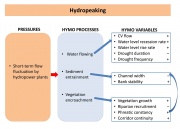Difference between revisions of "Hydropeaking"
(→Effect/Impact on (including literature citations)) |
(→Effect/Impact on (including literature citations)) |
||
| Line 21: | Line 21: | ||
Further indirect hyporheic effects were identified by Arnzten et al. (2007) who found empirical evidence of how changes in flow regime and in bed sediment permeability, relating to ingress of fine sediments, altered the vertical hydraulic gradient and water quality of the hyporheic zone within the Hanford Reach of the Columbia River in response to 2 m daily water level fluctuations due to hydropower generation. | Further indirect hyporheic effects were identified by Arnzten et al. (2007) who found empirical evidence of how changes in flow regime and in bed sediment permeability, relating to ingress of fine sediments, altered the vertical hydraulic gradient and water quality of the hyporheic zone within the Hanford Reach of the Columbia River in response to 2 m daily water level fluctuations due to hydropower generation. | ||
| + | [[File:Hydropeaking.jpg|thumbnail|Conceptual framework of hydropeaking hydromorphological (HYMO) processes and variables.]] | ||
*physico - chemical parameters | *physico - chemical parameters | ||
Revision as of 13:44, 31 August 2015
Contents
Hydropeaking
02. Flow regulations
General description
The production of electricity by hydropower plants is often implemented to satisfy peaks in electricity demand. For this reason these plants work intermittently, creating periodic and extremely rapid and short-term fluctuations in flow in the receiving water body. These fluctuations are called hydropeaking and usually show a marked weekly and daily rhythm.
Effect/Impact on (including literature citations)
- HYMO (general and specified per HYMO element)
Hydropeaking is a unique form of flow regulation, in that it introduces frequent, short duration, artificial flow events to the river. The theoretical framework related to the effects of hydropeaking is shown in Figure 6. The impacts of hydropeaking on channel size and morphology are highly dependent on the size and frequency of hydropeaks in relation to size of geomorphological effective flows prior to regulation. Where extreme hydropeaking leads to frequent geomorphological-effective flows (i.e. flows close to the bankfull stage), the hydropeaks dominate channel size and form because they readily mobilize bed sediments until the bed becomes heavily armoured by very coarse particles or scoured to bed rock. Such severe hydropeaking leaves few alluvial habitats and in-channel vegetation, and an abrupt transition between unvegetated and vegetated surfaces at the channel boundary. However, where hydropeaks are smaller and thus less competent to move bed sediment and the pre-existing geomorphologically-effective flows are significantly less frequent or no longer occur under the new hydropower dominated regime, physical adjustments may occur within the pre-existing channel. Sear (1995) describes an example of the latter situation, where the observed adjustments to the gravel-bed North Tyne River are indicative of channel narrowing and retention of fine sediment in the bed, in response to diurnal adjustments of river stage by approximately 0.6 m from hydropeaking: a) the development of fine sediment berms along channel margins, b) the aggradation of pools, c) the encroachment of vegetation on former gravel shoals d) the growth of tributary confluence bars. e) degradation of riffle spawning grounds: characterized by higher percentages of fines within spawning gravels, coarsening of surface gravels and the development of a stable, strong bed fabric. Hydropeaking has been found to have other more indirect hydromorphological impacts beyond those on channel morphology and sediments. Thus, Curry et al. (1994) found that short-term flow fluctuations affected hyporheos dynamics. Fluctuating flow levels altered groundwater pathways, chemistry, and flow potentials within the river bed. Rising river levels introduced river water into the bank where various degrees of mixing with groundwater occurred. Subsequent recessions of river levels increased the potentials for groundwater flow into the river channel. They found that these effects were significant at spawning and incubation sites and were thus potentially important for river ecology. Further indirect hyporheic effects were identified by Arnzten et al. (2007) who found empirical evidence of how changes in flow regime and in bed sediment permeability, relating to ingress of fine sediments, altered the vertical hydraulic gradient and water quality of the hyporheic zone within the Hanford Reach of the Columbia River in response to 2 m daily water level fluctuations due to hydropower generation.
- physico - chemical parameters
- Biota (general and specified per Biological quality elements)
Case studies where this pressure is present
- Drava_-_Kleblach
- Klebach_-_Side_channel
- Improvement_of_aquatic_habitat_of_Segre_River__at_Alòs_de_Balaguer
